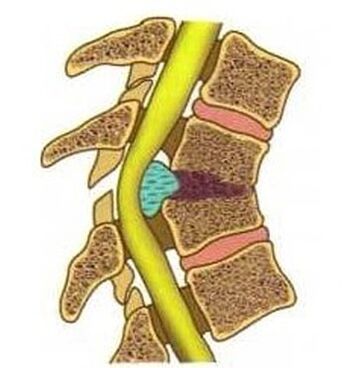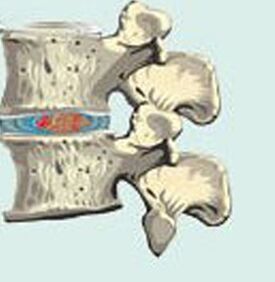Osteochondrosis is a degenerative-dystophical spinal disease, which shows the lesion of intervertebral discs in the form of deformation, reduction of height and stratification. The manifestations of this pathology are diverse, but they can be combined in several syndromes. Depending on the severity of the symptoms, the changes in the intervertebral discs surrounding their structures, several stages of osteochondrosis are distinguished. Before treating the osteochondrosis of the cervical region, it is important to find out why several medications are needed, physiotherapeutic and surgical methods are needed.

General Information
The osteochondrosis of the cervical column develops more frequently in people over 35, but sometimes its manifestations are observed at the age of 18 to 30 years. The cervical column consists of vertebrae, most of them are generally affected: the fifth, sixth, seventh.
Among the vertebrae there are intervertebral discs, which are a special form of the most durable cartilaginous bone connection. They provide the capacity of the spinal column to withstand significant loads and its mobility.
Each intervertebral album consists of:
- Octopus nucleus (jacket), which is a mass similar to gel.
- Dense fibrous ring that surrounds the disc nucleus.
- Two thin white fibrous cartilage plates that cover the discs from above and down.
The intervertebral discs are connected to the bodies of the vertebrae using a ligament apparatus.
The causes of osteochondrosis
In people over 20, the vessels that feed intervertebral discs are covered with weeds. In the future, these structures receive all the necessary substances by dissemination of several arranged vertebrae, but often these processes are insufficient for normal metabolism on the discs.
The osteochondrosis of the cervical column develops more frequently under the influence of:
- Hereditary predisposition.
- Anatomical anomalies of the cervical region.
- Overweight.
- A sedentary lifestyle associated with sedentary work, lack of physical effort.
- Trauma of the spine in the neck, including bruises, fractures.
- Metabolic disorders in the body.
- Age -related changes.
- Excessive physical effort.
- Frequent psycho -emotional stress.
These factors exacerbated the nutrition of intervertebral discs. As a result of this, the pulp nucleus is flattened, they become less elastic. The load in the fibrous rings increases, which is accompanied by their stretching, the formation of cracks in them.
At the bottom of such degenerative changes, the intervertebral disc can excel to the spinal channel. The irritation of the posterior longitudinal ligament rich in nerve endings is accompanied by local pains.

With the progression of the disease, there is a breakdown of the posterior longitudinal ligament, the intervertebral disc is protruding in the Cephalorrachide channel, this condition is called hernia. At the same time, the rooster syndrome is being developed, caused by the irritation of the closest brain spine, local autoimmune inflammation. If the artery of root thorns is squeezed, the blood supply to the spinal cord is altered.
The osteochondrosis of the cervical column is accompanied by the formation of osteofites, superior to bone tissue in bodies, vertebrae processes. These formations can also squeeze the roots of the spinal nerves or the spinal cord.
The first signals
The osteochondrosis of the Cervical-Toric Department in the initial stage is accompanied by tension, rapid fatigue of the muscles of this area. Subsequently, the discomfort, pain in the neck, neck, shoulders, intensification during inclinations, head turns, are bind.
Merozos, headaches: Other first signs of cervical osteochondrosis in women, men. Sometimes, a person experiences pain, a feeling of numbness, tingling in their hands after a night dream.
The main symptoms
The osteochondrosis of the cervical column is characterized more frequently by:
- root syndrome;
- Vertebral artery syndrome;
- Cardiological syndrome
Some people have reflex distribution syndromes, discogenic cervical myelopathy. Disorders in the emotional sphere, panic attacks with cervical osteochondrosis are also often observed.
Syndrome
The manifestations of the root syndrome are caused by compression (compression) of the root of the spinal nerves of the hernia of the intervertebral discs, the osteophytes of the bodies, the processes of the vertebrae themselves. As a result of the compression of nerve fibers, a local inflammatory reaction is developed, which is accompanied by pain through the cold of the affected nerve.

Therefore, with cervical osteochondrosis, symptoms such as neck pain, hands, back areas are produced. Unpleasant sensations can be observed in the heart, stomach. If the pain in the neck constantly remains, intensifies when turning, the inclination of the head, this condition is called cervicalgia. In addition, the pain can have the character of Lumbago, in hand, they are called service.
In those areas that innervate the affected nerve, there is a pronounced decrease in sensitivity. The muscles of this area are weakened, their atrophy can be observed, which is accompanied by a decrease in its volume.
Vail artery syndrome
The vertebral artery is an paired blood vessel that provides blood supply to the brain in 15-30%. When squeezing the vertebral artery, the various chronic manifestations of oxygen insufficiency in the central nervous system are observed by altered intervertebral discs, the growth of vertebrae.
In the development of this state, 2 stages are distinguished: functional, organic (ischemic). In the first one, the main symptoms of the vertebral artery syndrome with cervical osteochondrosis are frequent headaches. They become more pronounced in head movements, as well as while maintaining a position for a long time. The pains are hurt or pulsed, which are felt in occipital, temporal frontal areas.
The dizziness for cervical osteochondrosis is also characteristic of the functional stage of this syndrome. Its intensity is different: from a feeling of instability to a feeling of sudden fall or rapid rotation of the body. Sometimes hearing is reduced, a person can be disturbed by noise in his ears. Visual disorders are observed in the form of flies, flickering in front of the eyes.
With the progression of pathology, the ischemic stage occurs. It is characterized by temporary brain circulation disorders in the form of transient ischemic attacks, whose appearance is often caused by a rapid tilt or turn of the head.
Several options for vertebral artery syndrome are distinguished, with cervical osteochondrosis, whose manifestations have their own characteristics:
- Fall attack.
- Barre-lieou syndrome (rear cervical syndrome, cervical migraine).
- Basic migraine.
- Syncopa vertebral syndrome.
- Ophthalmic syndrome.
- Vegetative dysfunction syndrome.
- Ophthalmic syndrome.
- Kochleo-Investbular syndrome.
- Transient ischemic attacks.
With a fall attack, a person suddenly falls, throws his head, cannot move. There are no losses of consciousness, the ability to move independently after a few minutes. This condition is caused by an insufficient blood flow to the cerebellum, the brain trunk.
The cervical migraine syndrome occurs due to the compression of alternate interpretations or osteophytes of the nerve plexus surrounding the vertebral arteries. This condition is characterized by stupid headaches, which periodically become clicks. Usually, they arise if you have to maintain a forced head position for a long time, for example, this often happens after sleeping in an awkward pillow, when you work on the computer. Such headaches for the osteochondrosis of the cervical region are strengthened during the descent, climbing the stairs, trembling while driving in transport, walking quickly. The pains are found on the one hand in the occipital region, apply to the front parts of the head. They can persist several minutes in hours.

The manifestations of Syncopa's vertebral syndrome occur due to insufficient oxygen intake to the reticular formation of the brain. This condition is accompanied by a short -term fainting, with a long head stay, neck in a forced position.
The symptoms of cervical osteochondrosis in women, men in the form of pain, the feeling of sand in the eyes, sparks in front of them are some of the manifestations of an ophthalmic syndrome. There is a decrease in visual acuity, which is more pronounced with an increase in cargo in the eyes, a partial loss of vision fields is possible. The closure occurs, the redness of the conjunctiva is remarkable.
The attack of the basic migraine begins with a decrease in the vision of both eyes, noise in the ears, the deteriorated march, the lubrication of speech. Dizziness is also observed with cervical osteochondrosis of this course variant. Then there is a severe headache in the occipital region, accompanied by vomiting, the attack ends with a loss of consciousness.
With the development of a car-investbular syndrome, when it comes to the pathological process of the vertebral artery in the ears, a person indicates a decrease in hearing, and a perception of whisper is especially difficult. The feeling of instability of your body in space, a feeling of rotation of nearby objects.
The vegetative dysfunction syndrome reflects the disorders in the work of the autonomic nervous system in response to tighten the vertebral artery, nerve fibers located around it. It is characterized by a sensation of heat, episodes of chills, greater sweating. The feet, the palms become cold, wet to the touch and sewing pains in the heart. The vegetative symptoms of cervical osteochondrosis in men, women generally accompany the manifestations of other syndromes.
Transerta ischemic attacks are suddenly attacks on deteriorated coordination of movements, severe dizziness, speech disability, nausea and vomiting. If a person takes a horizontal position, these manifestations are generally reduced. After such an attack, a headache, weakness, flies, flashes in front of the eyes, the noise in the ears is preserved for some time.
Sometimes there is an increase in blood pressure with cervical osteochondrosis, which is also a consequence of tightening the vertebral artery. As a result, the brain area, which is responsible for pressure regulation, lacks oxygen. The same nerve impulses arise in it as with reduced blood pressure, under the influence from which it increases sharply.
Osteochondrosis development stages
As the degenerative changes are developed in the intervertebral discs, the osteochondrosis in its development passes several stages.
First grade osteochondrosis of the cervical region (preclinical stage)
The osteochondrosis of the Cervical-Toric Department at this stage is accompanied by muscle tension, discomfort. There is a slight softness of cervical lordosis (physiological flexion of the column in the form of a forward). Sometimes, pain occurs in this area, a temporary decrease in sensitivity in the necklace zone is possible.
Osteochondrosis 2 degrees
There is a feeling of weakness in the hands, numbness of the skin of the face, the neck, also decreases sensitivity in the upper extremities. The vision deteriorates, noise is observed in the ears.
Osteochondrosis 3 degrees
At this stage, there is a break in the intervertebral disc with or without its formation. The neck pain, the neck area becomes more pronounced, permanent, occurs in your hands.

Osteochondrosis 4 degrees
With the osteochondrosis of the cervical column, not only the intervertebral discs, the vertebrae, but also the nerve fibers, the blood vessels are involved in the pathological process, sometimes the spinal cord, the muscles, the joints of the upper half of the body are affected. The symptoms of the disease are diverse, they resemble the signs of other pathological conditions. If manifestations of osteochondrosis occur, you should immediately consult a doctor to undergo an exam.
First aid for severe pain
The treatment of the osteochondrosis of the cervical column in case of severe pain must be directed first to stop them. For this, drugs are used with analgesics. They are taken inside, to achieve a faster effect with cervical osteochondrosis, injections of solutions of these medications are recommended.
Sometimes a pepper patch is used, this tool irritates skin receptors, improves blood circulation in the use zone. As a result of such a distracting action, experienced pains seem less pronounced.
Physiotherapy
Treatment of cervical osteochondrosis in women, men with physiotherapy are aimed at:
- pain elimination;
- inflammation reduction;
- relaxation of spasmodic muscles;
- Improvement of metabolic processes, blood supply in the affected area;
- The release of roots from the spinal nerves violated with osteophytes (bone growth in the vertebrae).
The massage begins with stroking the collar zone in the direction from the spine to the supraclavicular axillary to the areas. Then the site are carried out, since the masseuse puts his hand with a border perpendicular to the spine, moves it from top to bottom. In the future, to heat the muscles, improve local blood flow, rubbing is used. The fingers are made by straight circular movements, starting from the base of the skull. Then, in a circular movement, the muscles love in the area of the necklace area. To complete the massage, vibratory movements are used in the form of brain shocks, as well as caressing.



















